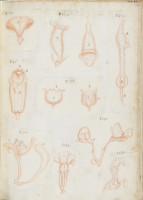Plant flowers
Date
1675
Creator
Unknown, Engraver
After
Marcello Malpighi (1628 - 1694, Italian) , Biologist
Object type
Library reference
54269
Material
Dimensions
height (page): 362 mm
width (page): 231mm
height (plate): 310mm
width (plate): 217mm
width (page): 231mm
height (plate): 310mm
width (plate): 217mm
Subject
Description
Sectional studies of the flowers of various plant species viewed under magnification, including:
Figure 133 [top left]: Bindweed, Convolvulus, referred to by Malpighi as Convolvulo.
Figure 134 [top centre]: Foxgloves, Digitalis, referred to as Digitali.
Figure 135 [top right]: Birthwort, Aristolochia, referred to as Aristolochiae longae.
Figure 136 [centre left]: Hyacinth, Hyacinthus, referred to as Hyacintho matthioli.
Figure 137 [centre]: Lily, Lilium, referred to as Lilio convallio.
Figure 138 [lower left]: Violet, Viola, and honeysuckle, Lonicera, referred to as Violarum and Caprifolii respectively.
Figure 139 [lower left]: White jasmine, Jasminum polyanthum, daffodil, Narcissus, bugloss, and primrose Primula vulgaris, referred to as Jasmino albo, Narcisso, Buglosso, and Primula veris respectively.
Figure 140 [lower right]: Bean, Phaseolus, and peaPisum sativum, referred to as Faba and Pisis respectively.
Figure 141 [lower right]: Nettle, Urtica, referred to as Horminio.
Inscribed: ‘Tab. XXIV’ in the top right-hand corner.
Table 24 from Marcello Malpighi's Anatome plantarum; cui subjungitur Appendix […] (1675).
Marcello Malpighi (1628-1694), Italian biologist and physician, was elected a Fellow of the Royal Society in 1669.
Figure 133 [top left]: Bindweed, Convolvulus, referred to by Malpighi as Convolvulo.
Figure 134 [top centre]: Foxgloves, Digitalis, referred to as Digitali.
Figure 135 [top right]: Birthwort, Aristolochia, referred to as Aristolochiae longae.
Figure 136 [centre left]: Hyacinth, Hyacinthus, referred to as Hyacintho matthioli.
Figure 137 [centre]: Lily, Lilium, referred to as Lilio convallio.
Figure 138 [lower left]: Violet, Viola, and honeysuckle, Lonicera, referred to as Violarum and Caprifolii respectively.
Figure 139 [lower left]: White jasmine, Jasminum polyanthum, daffodil, Narcissus, bugloss, and primrose Primula vulgaris, referred to as Jasmino albo, Narcisso, Buglosso, and Primula veris respectively.
Figure 140 [lower right]: Bean, Phaseolus, and peaPisum sativum, referred to as Faba and Pisis respectively.
Figure 141 [lower right]: Nettle, Urtica, referred to as Horminio.
Inscribed: ‘Tab. XXIV’ in the top right-hand corner.
Table 24 from Marcello Malpighi's Anatome plantarum; cui subjungitur Appendix […] (1675).
Marcello Malpighi (1628-1694), Italian biologist and physician, was elected a Fellow of the Royal Society in 1669.
Object history
Anatome Plantarum was a much-anticipated work and, along with Nehemiah Grew FRS (1641-1712), earned Malpighi acclaim as founder of the microscopic study of plant anatomy.
His research was encouraged and supervised by the Royal Society, as evidenced by correspondence between him and the then-Secretary, Henry Oldenburg FRS (1619-1677) in the 1660s and 1670s [MS/103/1]. An abstracted version of his work in this area was first read at a Society meeting on 7 December 1671 [JBO/4, pp.216-217]. The full manuscript of Anatome Plantarum, together with the frontispiece artwork and these plates, was received and read on 28 January 1674/75 [MS/103/1-2].
It was ordered for printing by the Society’s printer John Martin in June 1675 [CMO/1/221]. The published work consists of the text of Anatome Plantarum, De ovo incubato, and 61 plates illustrating each [54 and 7 respectively]. A second part was sent by Malpighi to the Society in 1678 and published in 1679 as Anatomes plantarum pars altera [54271].
His research was encouraged and supervised by the Royal Society, as evidenced by correspondence between him and the then-Secretary, Henry Oldenburg FRS (1619-1677) in the 1660s and 1670s [MS/103/1]. An abstracted version of his work in this area was first read at a Society meeting on 7 December 1671 [JBO/4, pp.216-217]. The full manuscript of Anatome Plantarum, together with the frontispiece artwork and these plates, was received and read on 28 January 1674/75 [MS/103/1-2].
It was ordered for printing by the Society’s printer John Martin in June 1675 [CMO/1/221]. The published work consists of the text of Anatome Plantarum, De ovo incubato, and 61 plates illustrating each [54 and 7 respectively]. A second part was sent by Malpighi to the Society in 1678 and published in 1679 as Anatomes plantarum pars altera [54271].
Associated place
